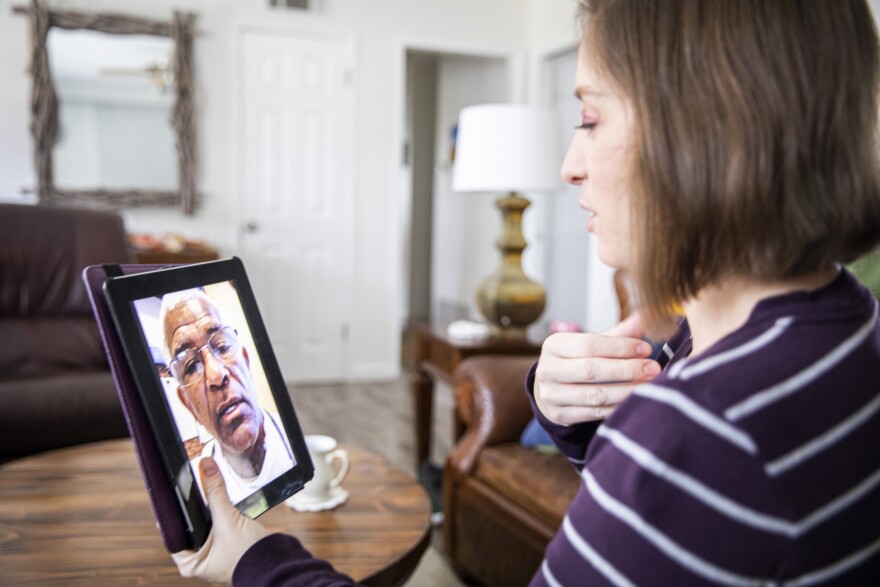The Veterans Health Administration is turning to virtual appointments to care for some patients who would otherwise be at risk for coronavirus. But the agency’s telehealth infrastructure has struggled to keep pace with the increasing traffic, causing providers and patients to get kicked off.
Before coronavirus shut down his community in the Denver suburbs, Antonio, an Army veteran in his late 30s, made several trips each month to the Rocky Mountain VA to see his healthcare team: a primary care physician, psychologist and social worker. (He asked that the American Homefront Project withhold his last name because he has disability claims being adjudicated by the VA.)
In early March, Antonio received a text from the Department of Veterans Affairs, warning him that his healthcare routine would soon change. The VA would remain open for in-person care if needed, but would reserve appointments primarily for veterans with urgent medical needs.
“The message made us aware that everything going forward would be over the new telehealth video chat system,” he said.
Antonio downloaded the VA’s Video Connect app to his smartphone, as instructed. But when it came time for his first virtual appointment things started to go awry. His social worker appeared in the chat room, smiling warmly and gesturing with her hands.
“Immediately we had video but no audio,” Antonio remembered. “I could see that she was talking. I looked at her and pointed to my ear and nodded my head, like, ‘No I can’t hear you.’”
The provider made some adjustments on her end, but the audio and video feeds kept alternating.
“Then we can hear each other, but not see each other,” he said. “It just wasn’t working at all.”
Entering and exiting the app didn’t help. With minutes ticking by, the two opted to finish the appointment using Apple FaceTime instead.
Antonio said he doesn’t think the problem was on his end. He has high speed internet, and considers himself tech savvy. Instead, he said he believes the issue was either user error or a bad connection on the provider’s side.
Two subsequent telehealth visits were a mixed bag: one went flawlessly, but the other had audio issues.
“That's the thing,” Antonio added. “The quality’s kind of all over the place. It's either really smooth or really bad. There’s no in-between.”
A Quick Shift To Telehealth
The VA has been building out its telehealth infrastructure for years, initially catering to rural veterans who lived far from VA facilities. From there, the agency began to offer new services and expanded to include more veterans who wished to remain at home.
But starting in March, as providers and patients self-quarantined, the number of virtual visits spiked from about 2,000 visits per day to nearly 20,000, straining the platform.
“Probably the most common difficulty is having a hard time understanding what the veterans are saying, which is usually a bandwidth or reception issue on their end,” said Dr. Ira Kedson, president of the American Federation of Government Employees chapter in Coatesville, Pennsylvania, and a VA psychologist. “But who knows, because we're all sharing the same VA Video Connect bandwidth.”
Getting onto the platform — and staying on — can be a challenge too.
“There are times when providers can't get into the sessions. We get an error message saying that the resource is not available,” he said. “There are times when people will get kicked off.”
In response to the sheer number of visits, the VA has rushed to expand its virtual health infrastructure. Last month the department got more than $2 billion from Congress to support its quick shift to telehealth.
Among other things, the CARES Act funding will help build on existing IT networks and enhance the VA’s ability to offer telehealth visits.
In-House Connections
Internal medicine doctor Leonie Heyworth, head of synchronous telehealth, said the agency built its own infrastructure in order to meet health privacy standards and allow for certain veteran-focused functions.
“The architecture by which we deliver the connections and the actual link to connect to the video visit is something that… we have built for VA uniquely,” Heyworth explained.

In response to the pandemic, the VA has tried to increase the amount of bandwidth available to providers who are working remotely. It’s also beefing up its servers to allow more people to use VA Video Connect at once.
“We had planned to increase the capacity gradually over time. But because of the time-sensitive need — a real pivot to the virtual care offerings — we wanted to make sure that there were plenty of connections available for people to be in session at the same time,” said Heyworth.
The VA doesn’t track how many video visits fail or drop out, though it’s working toward that. Heyworth admits the transition to telehealth has been challenging on the VA side. But she pointed out that many factors influence how well virtual visits go.
“Because of the variability in cellular signal where some of our veterans live, variability in broadband access, it can be difficult to know, connectivity-wise, without really doing an analysis,” Heyworth said.
While the telehealth ramp-up continues, the VA has made it possible for patients and practitioners to use other private video platforms, like FaceTime, Doxy.me and Cisco WebEx, as alternatives.
If all else fails, appointments can take place on another very familiar conferencing tool: the telephone.
Carson Frame can be reached at Carson@TPR.org and on Twitter at @carson_frame.
This story was produced by the American Homefront Project, a public media collaboration that reports on American military life and veterans. Funding comes from the Corporation for Public Broadcasting.
TPR was founded by and is supported by our community. If you value our commitment to the highest standards of responsible journalism and are able to do so, please consider making your gift of support today.




